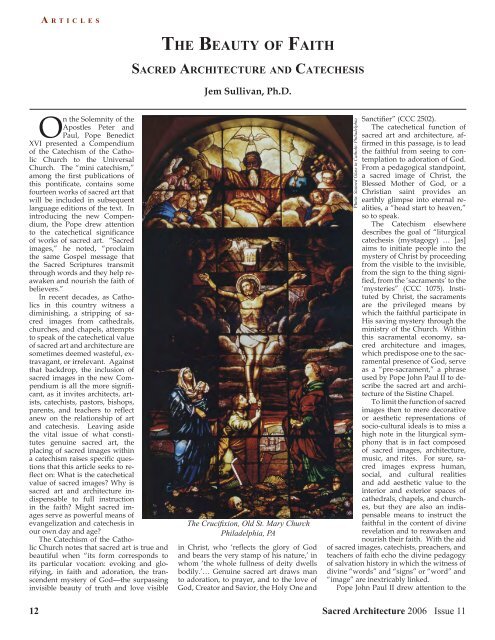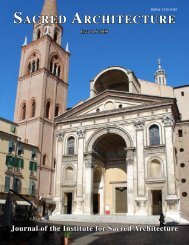Download Issue PDF - The Institute for Sacred Architecture
Download Issue PDF - The Institute for Sacred Architecture
Download Issue PDF - The Institute for Sacred Architecture
Create successful ePaper yourself
Turn your PDF publications into a flip-book with our unique Google optimized e-Paper software.
A R T I C L E S<br />
On the Solemnity of the<br />
Apostles Peter and<br />
Paul, Pope Benedict<br />
XVI presented a Compendium<br />
of the Catechism of the Catholic<br />
Church to the Universal<br />
Church. <strong>The</strong> “mini catechism,”<br />
among the first publications of<br />
this pontificate, contains some<br />
fourteen works of sacred art that<br />
will be included in subsequent<br />
language editions of the text. In<br />
introducing the new Compendium,<br />
the Pope drew attention<br />
to the catechetical significance<br />
of works of sacred art. “<strong>Sacred</strong><br />
images,” he noted, “proclaim<br />
the same Gospel message that<br />
the <strong>Sacred</strong> Scriptures transmit<br />
through words and they help reawaken<br />
and nourish the faith of<br />
believers.”<br />
In recent decades, as Catholics<br />
in this country witness a<br />
diminishing, a stripping of sacred<br />
images from cathedrals,<br />
churches, and chapels, attempts<br />
to speak of the catechetical value<br />
of sacred art and architecture are<br />
sometimes deemed wasteful, extravagant,<br />
or irrelevant. Against<br />
that backdrop, the inclusion of<br />
sacred images in the new Compendium<br />
is all the more significant,<br />
as it invites architects, artists,<br />
catechists, pastors, bishops,<br />
parents, and teachers to reflect<br />
anew on the relationship of art<br />
and catechesis. Leaving aside<br />
the vital issue of what constitutes<br />
genuine sacred art, the<br />
placing of sacred images within<br />
a catechism raises specific questions<br />
that this article seeks to reflect<br />
on: What is the catechetical<br />
value of sacred images? Why is<br />
sacred art and architecture indispensable<br />
to full instruction<br />
in the faith? Might sacred images<br />
serve as powerful means of<br />
evangelization and catechesis in<br />
our own day and age?<br />
<strong>The</strong> Catechism of the Catholic<br />
Church notes that sacred art is true and<br />
beautiful when “its <strong>for</strong>m corresponds to<br />
its particular vocation: evoking and glorifying,<br />
in faith and adoration, the transcendent<br />
mystery of God—the surpassing<br />
invisible beauty of truth and love visible<br />
THE BEAUTY OF FAITH<br />
SACRED ARCHITECTURE AND CATECHESIS<br />
Jem Sullivan, Ph.D.<br />
<strong>The</strong> Crucifixion, Old St. Mary Church<br />
Philadelphia, PA<br />
in Christ, who ‘reflects the glory of God<br />
and bears the very stamp of his nature,’ in<br />
whom ‘the whole fullness of deity dwells<br />
bodily.’… Genuine sacred art draws man<br />
to adoration, to prayer, and to the love of<br />
God, Creator and Savior, the Holy One and<br />
Sanctifier” (CCC 2502).<br />
<strong>The</strong> catechetical function of<br />
sacred art and architecture, affirmed<br />
in this passage, is to lead<br />
the faithful from seeing to contemplation<br />
to adoration of God.<br />
From a pedagogical standpoint,<br />
a sacred image of Christ, the<br />
Blessed Mother of God, or a<br />
Christian saint provides an<br />
earthly glimpse into eternal realities,<br />
a “head start to heaven,”<br />
so to speak.<br />
<strong>The</strong> Catechism elsewhere<br />
describes the goal of “liturgical<br />
catechesis (mystagogy) … [as]<br />
aims to initiate people into the<br />
mystery of Christ by proceeding<br />
from the visible to the invisible,<br />
from the sign to the thing signified,<br />
from the ‘sacraments’ to the<br />
‘mysteries” (CCC 1075). <strong>Institute</strong>d<br />
by Christ, the sacraments<br />
are the privileged means by<br />
which the faithful participate in<br />
His saving mystery through the<br />
ministry of the Church. Within<br />
this sacramental economy, sacred<br />
architecture and images,<br />
which predispose one to the sacramental<br />
presence of God, serve<br />
as a “pre-sacrament,” a phrase<br />
used by Pope John Paul II to describe<br />
the sacred art and architecture<br />
of the Sistine Chapel.<br />
To limit the function of sacred<br />
images then to mere decorative<br />
or aesthetic representations of<br />
socio-cultural ideals is to miss a<br />
high note in the liturgical symphony<br />
that is in fact composed<br />
of sacred images, architecture,<br />
music, and rites. For sure, sacred<br />
images express human,<br />
social, and cultural realities<br />
and add aesthetic value to the<br />
interior and exterior spaces of<br />
cathedrals, chapels, and churches,<br />
but they are also an indispensable<br />
means to instruct the<br />
faithful in the content of divine<br />
revelation and to reawaken and<br />
nourish their faith. With the aid<br />
of sacred images, catechists, preachers, and<br />
teachers of faith echo the divine pedagogy<br />
of salvation history in which the witness of<br />
divine “words” and “signs” or “word” and<br />
“image” are inextricably linked.<br />
Pope John Paul II drew attention to the<br />
12 <strong>Sacred</strong> <strong>Architecture</strong> 2006 <strong>Issue</strong> 11<br />
Photo: Stained Glass in Catholic Philadelphia










